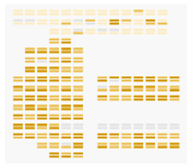What are the issues?
Almost every PV plant is suffering from soiling, from
temporary or partial shading, from underperforming modules and from degrading
modules.
Hassle with soiling is that it is unevenly distributed throughout the plant. Our test plant in Pune, India showed that diversification of soiling throughout a plant can vary by 8%.
That’s why spot measurements – the usual tool when measuring soiling – are not appropriate to see these variations.
Fixed cleaning cycles, either in frequency and amount, are ineffective and unnecessary costs.
► Dynamic cleaning schedules according to
actual condition is needed!

Example of soiling distribution of a plant, seen in the SunSniffer WebPortal; the darker the more soiled.
Some shades are unavoidable, like the wandering shade of a lamp post. Others can be removed, like vegetation.
► A clear differentiation
between these is needed!
An extensive study from ZAE with more than 160.000 showed that 8% of all modules were broken, 34% of all modules had some kind of failure. How can these be found with inverter or string monitoring only?
► Automated
classification is needed for most efficient O&M and exchange services!

Classification of modules into loss classes, seen in the SunSniffer WebPortal.
A study from Arizona State University revealed that 42-76% of all modules are eligible for warranty replacement.
But how can you find these, without excessive – and expensive – error search?
And once found – how to prove warranty claims without producing further costs for institutional inspection?
And without wasting more time with modules producing less than they should until the case is cleared?
► Constant degradation monitoring for each
module is needed and a warranty case report at the push of a button!



